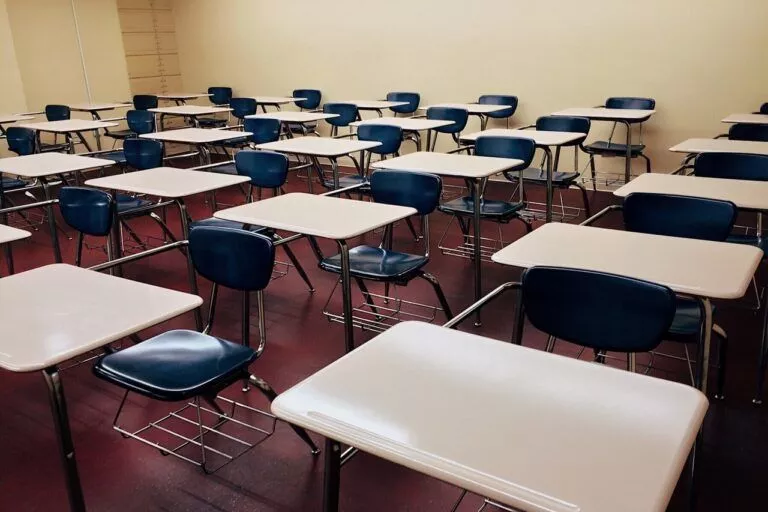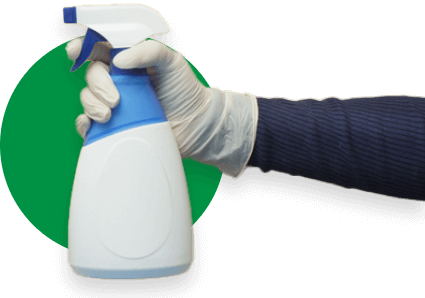In a perfect world, we could send kids to school knowing it’s a perfectly clean and healthy place, without worrying about them coming home sick. Unfortunately, the reality is schools collect dirt, debris, and germs fast, accelerating the spread of illness to the whole community.
Minors are at elevated risk for the flu. Elementary school children get sick 6-8 times annually with colds/upper respiratory infections, while high school aged kids get colds 3-4 times per year. When young children have to stay home sick, parents have to stay home too, or find alternative childcare. Students can spread germs to their families and teachers too, costing schools tons of money in sick leave.
Deep cleaning is vital, but only happens a few times per year. How do you keep an entire school clean every day after hundreds or thousands of people spend the day eating, drinking, throwing out trash, using bathrooms and locker rooms, going back and forth between shared spaces, touching the same surfaces, and tracking dirt and dust around?
In this expert school cleaning guide, we’re covering the advantages of cleaner schools and the challenges of maintaining clean conditions in schools, providing a step-by-step guide. Keep reading for everything you need to know, and stay tuned for our brief FAQs at the end.
Advantages to Having a Clean School
The problems and risks resulting from poor conditions at school are clear. But what about the benefits of prioritizing school cleanliness? Let’s define some of the foremost goals underlying any school cleaning action plan.
Students learn in a clean environment that is free of distractions.
Poor school conditions can cause emotional and physical distress and distractions. Kids with allergies and asthma will struggle even more when mildew, pollen, and dust get out of control and when dirty ducts and vents impact the air quality. Plus, some students even admit they refuse to eat or drink during school hours just to avoid using the bathrooms.
The direct distractions from being uncomfortable in a neglected school environment and the indirect distractions from being hungry and thirsty all day to avoid the restroom inevitably impede students’ learning.
Additionally, some studies have revealed a link between student absences and lower academic success. On the other hand, a clean, tidy learning environment is the most basic step towards giving students their best chance to focus and succeed. Especially when kids spend more time in class instead of staying home sick.
Teachers have a clean and organized space to work in.
Teaching can be tough. Budgets are always shrinking for essential supplies, class sizes are always growing, and multitasking is constant. Your faculty already spends many hours beyond the school day working on lesson plans, grades, professional development, and communication with parents.
Therefore, proper school cleaning helps you avoid overwhelming teachers with excess cleaning duties. Organized, hygienic workspaces keep them from getting sick and becoming uncomfortable or distracted while they’re trying to teach.
Children, faculty, staff, and the community are less likely to get sick.
The recent COVID-19 pandemic has increased our awareness of how fast illnesses can spread throughout a community. When kids, faculty, and staff catch something at school, they may spread those viruses and bacteria to their families, friends, and the rest of the public wherever they go before they realize they’re sick.
Adequate school cleaning procedures help reduce the spread of bacteria, viruses, and resulting illness. Ultimately protecting the entire surrounding community.
Children feel proud of their school when it is clean and orderly.
Working in education, you observe kids don’t care what you know until they know you care. This is one of the most important foundations of a healthy school culture.
Children can tell when the adults caring for them are ensuring their basic health and safety needs are being met. A clean, orderly, safe school nurtures a sense of respect, pride, and comfort ideal for learning and school etiquette.
Parents feel reassured about sending their kids to a safe, healthy place.
Whether it’s a public or private school, a safe, healthy environment is the bare minimum of parents’ expectations. You can’t wait until parent-teacher meeting nights or the next big event to clean the school.
Instead of worrying about the conditions at school being distracting, uncomfortable, unhealthy, or unsafe, it’s an absolute must to properly maintain the building and give the parents peace of mind while their kids are in your care all day.
School equipment and facilities last longer.
The budget is a big deal when running a school. Every dollar you spend on costly repairs and replacements is another dollar diverted from school supplies like books.
Regular cleaning is a great investment to extend the lifespans of existing equipment and facilities such as floors, plumbing, air ducts, desks, chairs, dry erase/chalk boards, electronics, kitchen appliances, and more.

Why Keeping a School Clean is Challenging
Everyone knows classrooms, gyms, cafeterias, auditoriums, and hallways can get very crowded. What are some of the other hurdles compounding the difficulty of keeping a school clean? Here’s a list of some unique school cleaning challenges key to developing a routine cleaning strategy.
Young children are still learning personal hygiene
Young kids are still in the process of learning hygiene habits, just like everything else. They sit and play on the floor, share food and drinks, and they’re usually not the best at avoiding touching their faces, covering coughs and sneezes, blowing their noses, washing and sanitizing their hands.
Therefore, it’s extra important to thoroughly clean floors, eliminate slip and trip hazards, disinfect and sanitize all high-touch surfaces, and pay particular attention to any shared supplies.
Students often track in dirt and mud from the outdoors
When kids arrive in the morning or go outside for class and gym activities, dirt and mud comes with them. On a rainy day, it’s even worse. Imagine the cumulative amount of dirt and mud on the shoes of hundreds to thousands of people in a school building.
High-traffic places like gyms, auditoriums, and cafeterias
Kids never show up to their classroom and stay there for the entire day. They visit high-traffic places like bathrooms, gymnasiums, auditoriums, and cafeterias, increasing dirt build-up and maximizing the likelihood of spreading illnesses.
Many students eat snacks and lunches in their classrooms, which can create a lot of mess
The cafeteria isn’t the only place that sees frequent food messes. Classroom snack times and lunches create plenty of opportunities for spills, crumbs, stains, you name it.
Dirt and debris spreads through the building with everyone walking through busy school halls
Every student comes inside the school and travels back and forth to different parts of the school throughout the day using busy hallways. So when everybody steps on the same dirty floor mats at entrances and walks through the same floor, dirt and debris, messes spread quickly to almost every floor in the building.
Step-by-Step Guide to Keeping Your School Clean
With school cleaning, we’re talking about thousands upon thousands of square footage of space which may seem utterly impossible to keep clean and organized. It helps to break it down into actionable steps like these:
Correctly Use the Right Tools
Having the right supplies and tools is just the first step. But anyone using cleaning materials must understand any potential hazards involved and how to properly use harsh cleaning chemicals like bleach and ammonia.
Store all cleaning materials in appropriate containers with the original labels, warnings, and instructions. Ensure anyone using them carefully follows the cleaning directions such as dilution to protect themselves and anyone else who might come into contact with the cleaning chemicals. Avoid mixing any cleaning chemicals unless the label explicitly directs the user to do so.
Remove Trash Systematically
Expect students, faculty, and staff to throw out their personal trash with separate bins for recycling. Have a process for collecting any stray garbage from floors or elsewhere, then consolidate and remove all trash bags.
Clear Clutter and Organize
Throughout the day, teachers should be keeping their workspaces relatively organized and encouraging students to do the same. But clear any leftover clutter like books and school supplies or trip hazards like chairs and cords in walking paths.
Clean in Logical Segments
Divide and conquer. Section off different areas and prioritize them based on the amount of traffic they get, the frequency of use, the complexity of cleaning, and how much work you expect regular cleaning to take.
For example, rooms getting less frequent use don’t need top-to-bottom cleaning as often as the classrooms, cafeteria, bathrooms, and halls. The gymnasium is usually a large but relatively simple space to clean compared to other rooms.
Use considerations like these to craft an itemized schedule of daily, weekly, monthly, and seasonal cleaning tasks. Track how well your procedures are working in each space and adjust accordingly as you go.
This consistency will help you perfect your cleaning approach over time and keep cleaning supplies stocked while anticipating and regulating cleaning costs and labor.
Bathrooms and locker rooms
In bathrooms and locker rooms, focus on trash removal and surfaces like lockers, benches, showers, toilet stalls, floors, sinks, and mirrors. Replace consumables such as toilet paper, paper towels, and hand soap.
Gym
Learn about specific cleaning methods you may need to follow based on the gym’s flooring material, whether you have wood floors, vinyl/synthetic, or polypropylene, rubber, or acrylic tiles. Plan floor care like polishing, buffing, waxing, etc.
Any mats, gym equipment, storage spaces, bleachers, and mats should be disinfected, and high surfaces need periodic dusting.
Auditorium
Auditoriums are often home to lots of upholstery, carpet, and high surfaces like lights and sound equipment. These spaces may not need cleaning as often, but upholstery and carpet cleaning will be necessary, as well as attention for light fixtures and other out-of-reach surfaces prime for becoming dust magnets.
Classrooms
Besides frequent floor cleaning, the biggest concerns in the classroom will include trash and clutter removal. In addition to addressing all frequent touch points like desks, carpets, bookshelves, dry erase/chalkboards, light switches, electronics, and doors.
Laboratory rooms
Be informed of special cleaning needs in any science/chemistry labs that have PPE like goggles, specialized equipment and tools, flammable materials, and various chemicals.
Library and computer rooms
Libraries and computer rooms will need the shelves dusted, desks, chairs, and other high-touch surfaces disinfected, carpets and hard floors cleaned, and electronics wiped down safely.
Hallways and entryways
In all hallways and entryways, remove trash, debris, and dirt. Mop, sweep, or vacuum the floors as needed, wipe smudges and fingerprints off of windows, and disinfect doors and railings.
Offices and Copier Rooms
The desks, computers, printers/copiers, chairs, phones, and shared supplies should get cleaned regularly. Prioritize the doors and other high-touch surfaces faculty and guests use when checking into the building.
Teacher’s lounge
On a weekly basis, clear out any old food from refrigerators. Every day, wipe sinks, tables, counters, and chairs, and clean appliances like coffee makers, microwaves, and fridges.
School cafeteria
The cafeteria and kitchen require extra caution to safely serve food. Oversee correct waste disposal and ensure all food storage, prep, and dining areas are cleaned up to food and beverage industry standards daily. The tables, chairs, and floors should get a once-over in between uses to help keep messes manageable on a daily basis.
Outside
Empty outdoor trash cans every day, collect trash from on the ground or around bleachers, and occasionally, it may help to pressure wash walkways and clean window exteriors.
Regularly Disinfect
Disinfecting and sanitizing individual key surfaces every day is a necessity, but you need top-to-bottom school disinfection occasionally, too. Practices like electrostatic disinfecting can help kill 99% of illness-causing viruses and bacteria.
Make Plenty of Trash and Recycle Bins Available Around the Premises
To help reduce the presence of litter on the floors and outside, have plenty of trash cans and recycle bins available. Students, staff, and faculty can conveniently dispose of garbage without a second thought, eliminating extra work for cleaning staff.
Raise Teacher, Staff, and Student Awareness
Create a culture of respect for the building and each other. Educate everyone about the advantages of a cleaner school, like getting sick less often. During cold and flu season, encourage everyone to be even more diligent.
Remind adults in the building they can set a good example for students. Set specific expectations for everyone, kids and grownups alike to help keep the school clean, healthy, and safe.
Once the whole school establishes positive hygiene and cleanup habits, it’s quick, easy, and automatic to wash/sanitize hands, throw out trash, clean up messes, and stay neat and organized.
Invest in Professional School Cleaning Services
Many schools employ their own janitorial/custodial staff. But for some, outsourcing may be more cost-effective, and many schools likely need outside help with deep cleaning, disinfecting, and commercial cleaning jobs like specialized floor or equipment maintenance.
If you need help from a professional cleaning company to clean a school in the Dallas-Fort Worth area, trust Dallas Janitorial Services. You’ll get help from dedicated teams with thorough background checks, 24/7 availability, and affordable expert cleaning, sanitizing, and disinfecting methods.

FAQs About Keeping Schools Clean
How much should you invest in school cleaning services?
The reasonable price range of school cleaning services by a professional cleaning company depends on many variables such as the square footage, number and types of rooms, and the kinds of surfaces that need cleaning, such as various floor materials.
But cleaning/janitorial services from a professional cleaning company are a worthy investment to maintain the condition of school facilities and prolong the need for repairs and replacements.
How often should classrooms get cleaned to maintain cleanliness?
To keep them safe and healthy, classrooms should receive daily basic cleaning for floors, trash removal, and frequent touch points.
How often should school restrooms get cleaned?
In school restrooms, sanitize all high-touch surfaces, clean floors, remove the garbage, and restock supplies like hand soap, tissue, and paper towels every day.
Should students help clean classrooms?
Kids can certainly help organize the classroom, clean up their own messes, and get rid of the trash. But they cannot be expected to use harsh or hazardous disinfectants or cleaning products.
When is the best time to deep clean the school?
School deep cleaning is quite an undertaking, so it’s usually best to conduct them a couple of times annually. Most schools schedule a deep cleaning for summer, winter, and spring breaks.
How can your school cleaning approach improve?
Are there some tasks like trash removal, disinfecting, or floor deep cleaning the school needs more often? Is it time to start a conversation with students, faculty, and parents about new cleanliness standards? How can your school community work together for a more productive learning environment?
Contact Dallas Janitorial Services, tell us about your building and any unique challenges or concerns, and we’ll estimate a free school cleaning quote.







